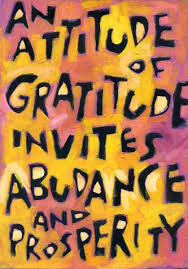This chapter excerpted from Appreciative Moments: Stories and Practices for Living and Working Appreciatively. iUniverse, 2008. With permission of the author, Ed Jacobson
Chapter 32: An Abundant Thanksgiving Week
My mind’s been cooking lately about the rapidly-approaching Thanksgiving holiday and the piece I’ve wanted to write about having An Appreciative Thanksgiving Day. Then a new notion arose: Why not think about an Abundant Thanksgiving Day? I love the concept of abundance. It can refer to financial or material abundance, but it embraces much more than that. I conceive of it as a sense of fullness, ripeness, brimming with life, in various sectors of our lives: financial, familial, spiritual, religious, community, work, health, psychological …the list of abundance areas goes on and on. In fact, I’ve created an instrument called the Life Abundance Portfolio© which gives people the opportunity to explore their sense of abundance in a range of key areas in their life. So, let’s call it an Abundant Thanksgiving Day, and explore what that might consist of.
When I think of an abundant Thanksgiving, I think first of food. Then my mind goes to the people who have gathered together.  Whether it’s a small family dinner, a large group of friends and family, or a gigantic church dinner, there’s generally good cheer and at the very least a temporary cease-fire. We tacitly agree to put aside our differences and our weapons of mass reactivity. We break bread together, instead of bristling at Aunt Maud or grimly tolerating cousin Max. We enjoy the good fellowship while we can. Someone is likely to saythat we should do this more often, and not just on our national Turkey Day.
Whether it’s a small family dinner, a large group of friends and family, or a gigantic church dinner, there’s generally good cheer and at the very least a temporary cease-fire. We tacitly agree to put aside our differences and our weapons of mass reactivity. We break bread together, instead of bristling at Aunt Maud or grimly tolerating cousin Max. We enjoy the good fellowship while we can. Someone is likely to saythat we should do this more often, and not just on our national Turkey Day.
Instead of simply nodding your agreement, respond instead with “What a wonderful idea! How can we make that happen?” See what energies arise, both in you and others. Maybe a couple of you who have energy around the idea can nominate yourselves as the group to make it happen. It only takes a couple of committed people. Recall Margaret Mead’s classic statement: “Never doubt that a small group of thoughtful, committed citizens can change the world; indeed, it’s the only thing that ever has.”
Thinking more about an Abundant Thanksgiving Day, I think about gratitude and thanksgiving, and then about the people who spend Thanksgiving Day either alone, in prison, or in the hospital. Then I call to mind people on a street in a far-off land or, with alarming frequency, in our cities and even our rural areas. It’s a stretch for some of us (myself included) to hold the uncomfortable paradox of being surrounded by abundance while knowing that others near and far are so much less blessed materially. I wonder how other people make peace with that paradox, while at the same time asking someone to pass that fabulous-looking stuffing. This Thursday at Thanksgiving dinner with my family, I intend to verbally acknowledge our own bounty and others’ lesser material abundance, and vow to do more to contribute somehow more to these unknown others’ well-being.
How might we honor the spirit of giving thanks this year in a way that does two things:
• Creates as much appreciation as we can stand, and
• Addresses the question, How can we get more of this sense of appreciation, more days of the year?
Here are a couple of rituals of appreciation and abundance for Thursday, and three for the week leading up to the Big Day
Thanksgiving Day
1. The host or other Designated Appreciator (the D.A., for short) can tap a glass with a spoon, get everyone’s attention, and propose the following: “Could we capture the spirit of Thanksgiving by going around the table (or the room), and each one of us saying two or three things that you feel especially grateful or thankful for today?”
 And the host or the D.A. models the process by going first, thereby making it safe for people to be personal (and even profound) in their declarations. When everyone who wishes to has taken a turn, it might be appropriate for the D.A. to add, “I wonder if anyone has any thoughts about what we could do to have that sense of gratitude or thankfulness not just today, but more of the time?” And just wait. See what thoughts and insights are offered. If none arise, the D.A. might offer their own thoughts, and leave it at that. And then, of course, pass the stuffing.
And the host or the D.A. models the process by going first, thereby making it safe for people to be personal (and even profound) in their declarations. When everyone who wishes to has taken a turn, it might be appropriate for the D.A. to add, “I wonder if anyone has any thoughts about what we could do to have that sense of gratitude or thankfulness not just today, but more of the time?” And just wait. See what thoughts and insights are offered. If none arise, the D.A. might offer their own thoughts, and leave it at that. And then, of course, pass the stuffing.
2. Alternatively, the host or D.A. can suggest after dinner (if a football game isn’t on the TV and if everyone isn’t in the throes of a Tryptophan-induced nap) that folks share stories about a time during the past year when they felt especially blessed, in whatever area of their life. Depending on the size of the gathering, it may be best not to go around the room. It might more comfortable and lead to a deeper experience to gather in threes or fours, and give each person a couple or three minutes to tell their story to the listeners, whose job is simply to listen. Afterwards, the D.A. might say, “Wow! Here are some things I learned in listening,” relate what he heard, and wait to see who else wants to share.
The Week Before
1. Right now, look within yourself and look around you, and enumerate all the things you’re grateful for. Then at dinner this evening, report on your experience, mentioning a few of the items on your gratitude list. Invite others to do the same. Make the point that a day of thanks-giving doesn’t have to always fall on the fourth Thursday in November. You might be surprised at who reports, and at what they say.
2. Before Thursday, make an Abundance List. Write down the following Abundance Areas, or make up your own:
• Family
• Work
• Community
• Religion / Spirituality
• Health
• Friends
• Finances
• Stuff ( iPods, a car that works, comfortable
shoes, toothpaste)
In one or more of the above areas, list the things you feel abundant about. Place a check mark next to items that you can do something about having more of. You might then jot down specific actions to take. You may find, however, that simply making a check-mark serves to plant it in your mind and prompts you to take action. As always, do whatever works for you.
3. Here’s a final exercise to do in your mind’s eye before Thanksgiving Thursday: Picture each person you’ll be spending Thanksgiving Day with. Mentally make the rounds of the anticipated dinner table. For each person, silently identify what you love most about them, their most admirable qualities, or a memory of a happy time spent with them. Experience
the positive feelings that go with these positive memories. Repeat these mental rounds each day before Thursday, and watch what happens. You may find that it increases your sense of anticipation (which we can call Anticipatory Savoring), and your enjoyment of
Thanksgiving Day. And because of the positive energy you’ll be exuding when Thursday rolls around, you’ll be amplifying others’ enjoyment of the day.
I wish you and yours a Thanksgiving Week filled with abundance and appreciation. And 364 other days like that.
PRACTICES
1. Apply the first Designated Appreciator ritual during your Thanksgiving dinner, no matter how many people are around the table. Alternatively, apply the second Designated Appreciator ritual after the meal. (You can do either or both Practices even if you’re
dining alone. It may sound a little weird, but I’ve done it, and it works.) Almost invariably, when it’s over someone will express their thanks for your suggesting the exercise. After acknowledging their appreciation, then ask “How did this work for the rest
of you?”
2. Before Thursday, make your own Abundance List. Invite others in your household to make their own lists. On Thursday, suggest that everyone share their lists.
that everyone share their lists.
3. Invite members of your household to experience the pre-Thanksgiving guided imagery exercise of picturing who would be seated around the Thanksgiving dinner table. Ask them to share their images. Wonderful things can happen.
• Noting similarities between people in what they anticipate can be very confirming and enriching, and can also increase the savoring when Thursday comes.
• Discovering differences in what is anticipated can broaden everyone’s sense of abundance, and can also increase people’s understanding of each other’s frame of reference — always a good thing.
4. At least once per month, review your own Abundance List. See what happens when you de-link it from a milestone event like Thanksgiving and make it part of your ongoing routine.
5. Invite your family to conduct a monthly review of everyone’s Abundance List. It can become a meaningful family ritual.
This chapter excerpted from Appreciative Moments: Stories and Practices for Living and Working Appreciatively. iUniverse, 2008. Permission of the author.








